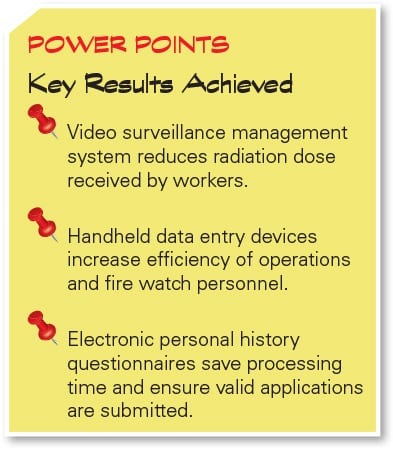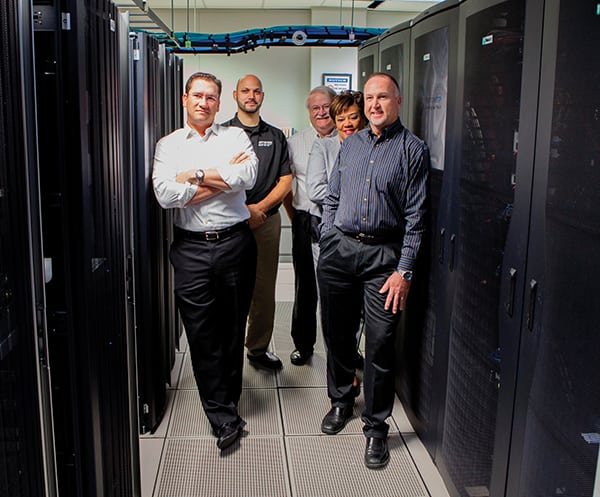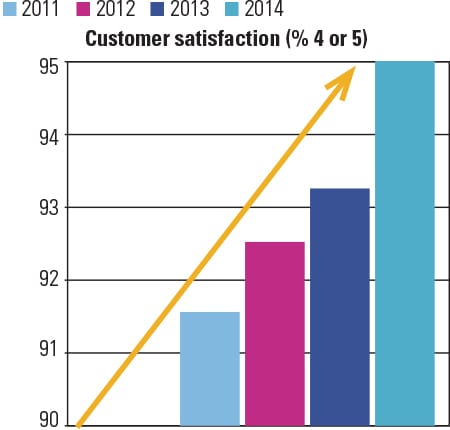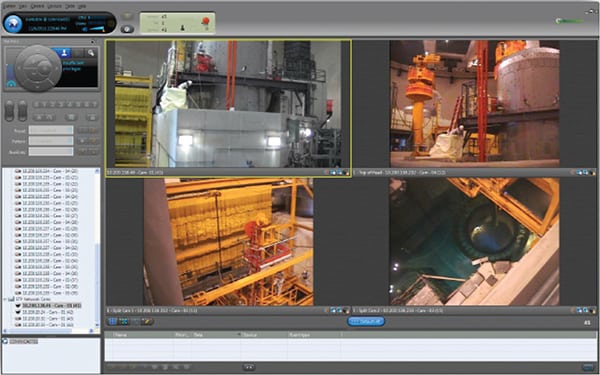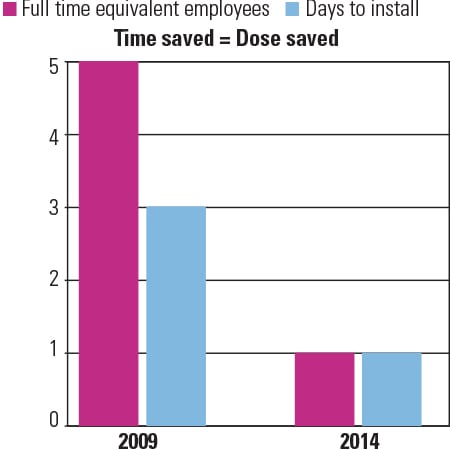Transforming Information Technology at the South Texas Project Nuclear Plant
In today’s world, it’s hard to operate a power plant without the benefit of information technology (IT) systems. Staff tasked with managing these systems can take a beating when the tools don’t work as advertised. Here’s how one IT department focused on building and sustaining cross-functional relationships, culminating in a win-win for the department and the company as a whole.
The South Texas Project Electric Generating Station (STP), located about 90 miles southwest of Houston, Texas, is one of the nation’s largest nuclear generating facilities. STP, however, is not immune to depressed power market conditions. Low natural gas prices, renewable power sources, and increased regulation, among other market constraints, continue to challenge baseload generation in Texas and across the nation.
To help address these challenges, STP’s Information Technology (IT) department has contributed innovative strategies, which have netted positive results for the company. Over the past three years, the IT department has been successful in reducing its operating budget by more than 10% while delivering value to the company through innovative solutions and improved employee morale.
Good Information Technology Requires Teamwork
IT team members feel as though they are a part of something much larger than themselves. A key portion of the department’s mission statement says it all: “a common purpose is shared with the station and positive, lasting relationships are fostered.” This may not seem like the typical IT mission, but building and maintaining relationships with people is at the heart of what STP’s IT department does. No matter how good the technological rollout, no matter how innovative, the team believes that if it does not maintain solid relationships with internal and external customers and stakeholders, it will fail.
The IT department, however, was not always well received at STP. In the early 2000s, STP’s executive management considered outsourcing IT. That decision was not considered based solely on economics; it also was contemplated because the value delivered by the IT organization at the time was believed to be lacking. In a 2011 interview with the maintenance department management, an unidentified worker responded to a question regarding the IT department’s performance with the following statement: “We fight with IT all the time! They think we work for them!”
Although IT staff’s actions were well intended, that was not the perception from stakeholders supported by the department. The technology department staff (Figure 1) had their work cut out for them. Over the next several years they would transform their department from a “can’t do” organization to a “can do,” value-adding organization. In fact, key performance indicators (KPIs) and recent surveys completed by plant and corporate personnel show significant improvements in levels of service delivered (Figure 2).
“We knew as an IT organization that we needed to change and become more customer focused,” said Waco Bankston, STP director of information support services. “It’s been a great experience to see teammates working together towards the common goal of speeding up the flow of information and delivering real value to the organization. Reducing the time it takes to get information to decision makers helps us achieve our mission of operational and financial excellence for the station.”
Implementing a Process Improvement Plan
As part of a multi-year strategic plan, the IT team, in partnership with station and corporate leadership, developed a four-pillar approach to help ensure the company delivered on its key results. These pillars were: financial optimization, operational excellence, people development, and value to customer.
The first action taken was to fully internalize and understand the company’s key results or long-term goals. Once these were understood, the IT department worked on its strategy to deliver on those key results with accuracy and quality.
The process involved several steps. First, a thorough review of IT projects both large and small was conducted to determine how they supported the larger organization’s key results. If there was a question as to their value-add to the overall organization, they were quickly culled from the list. Then, backlogged items were prioritized to ensure that the person-hours spent reducing the backlog would directly contribute to the company’s key results. Items were categorized according to the four pillars of long-term focus.
KPIs were created to measure the success of the four pillars. Once this process was completed, a holistic review of the strategy was conducted with IT and station leadership to ensure the connectedness of IT goals and long-term objectives with STP Nuclear Operating Co.’s key results. It was important for STP’s IT leadership to illustrate how projects that IT personnel worked on contributed to the company’s bottom line or helped add value to business and plant operations.
Departments Embrace Technology
Operational excellence was one of the four pillars and continues to be a focus for the technology department at STP. Over the past several years, key technologies have been put into place, which have proved to add tremendous value and efficiency to the way STP operates its business. The following examples are a few IT system improvements implemented in recent years.
Video Surveillance Management System. In 2012, IT worked with the Health Physics department to install a turnkey solution to view and capture video of outage activities. The innovative use of a software application called Omnicast—a video surveillance management system supplied by Genetec Inc.—allows users on the local area network to view video feeds from containment and other active outage areas around the station. The feeds may be viewed live as the activities are taking place or retrieved from archived footage on the server. The video feeds may also be shared with offsite vendors when necessary.
“The ability to do this has allowed us, on many occasions, to go back and critique entire evolutions and develop process improvements,” said Robert Bowers, STP Health Physics ALARA (as low as reasonably achievable) technician. Radiation exposure to personnel has decreased significantly since implementation of the Omnicast system (Figure 3). STP’s Health Physics team estimates that the plant is reducing dose by as much as 20% per outage, depending on the scope of activities. The new camera equipment is quick to install and remove, and requires fewer people to complete the task (Figure 4).
The magnetically mounted equipment allows fewer personnel to be inside the reactor containment, because supervisors and technical experts can view tasks remotely instead. Wireless access throughout the STP site, including in the power block and containment (more than 550 access points), has allowed IT staff to assist the plant and provide 24/7 recording of key activities.
Handheld Log-Taking Devices. Staying true to its vision of supporting operational performance, IT provided a valuable solution to STP operations and fire watch personnel. For years, personnel had performed their required rounds using printed documents to capture readings and observations while in the field. Although the method worked satisfactorily for the groups, it was not ideal. New technology offered an option for improving the process.
The IT department collaborated with their operations and fire watch teammates to develop a solution that allows operators to enter readings directly into a database, utilizing handheld devices (Figure 5). The application works in online mode or offline mode, and it synchronizes with the database whenever a wireless signal is detected.
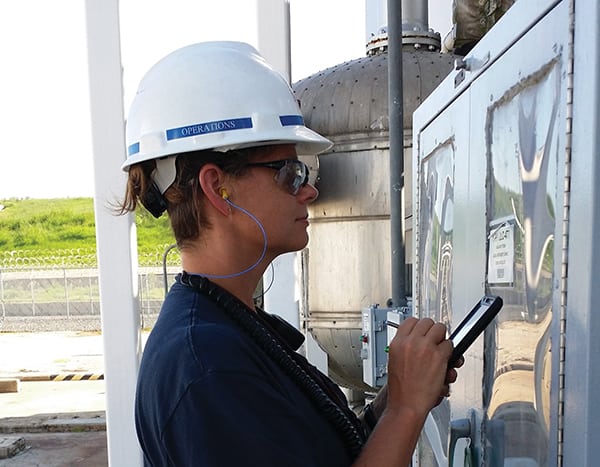 |
|
5. Touchscreen technology. The use of handheld devices allows more efficient data entry, tracking, and trending. Courtesy: STP Nuclear Operating Co. |
“The newest version of the handheld log-taking devices utilize wireless technology, which allows us to be much more efficient,” said STP Head Plant Operator Dave Creager.
Plant Access Application Tool. In addition to the innovation the IT department provided to the operations and fire watch groups, it was instrumental in developing a paperless solution for the plant access organization. An electronic personal history questionnaire (ePHQ) system was just what the plant needed.
“It was important that we made it easier for the people working in access authorization to have legible electronic information so they could reduce their frustration and improve efficiency at the same time. The drive was to help the employees in access authorization, and the ePHQ was the idea and tool to make it happen,” said Tim Bowman, STP’s nuclear support manager.
An individual applying to work at a nuclear facility has to complete a personal history questionnaire. That document is very long and tedious, especially for contractors moving from one plant to another plant. The paper process had several drawbacks, so the IT applications group searched for an electronic answer.
Customers brainstormed with the IT group to develop a solution that would offer an easy-to-use application for gathering data once from any individual wishing to work for STP. If individuals return to STP at a later date, they only need to submit relevant information that has changed since they last left the site.
The wizard-style web application walks the working professionals through the data entry process and ensures they submit a valid application. A substantial amount of effort is saved because of the tool’s implementation; in-processing time has been reduced by 24 to 48 hours per person. This is an added value during outage mobilizations, ensuring that individuals are processed and placed in the field as soon as possible.
“Our IT department helps the leadership team lead, manage, and interact with the workforce, bringing the elegance, simplicity, and intuitive nature we expect from technology,” said Aldo Capristo, executive vice president and CAO for STP.
Reliable Solutions Improve Efficiency
A person might think that implementing all of this new technology would generate additional work for IT support personnel, but the statistics seem to prove otherwise. While working on budget management and realignment, IT also worked at improving efficiency within its technical assistance center (TAC). The TAC logged 15% fewer calls in 2014 than it did in 2009 (Figure 6) and call volume is continuing its downward trend.
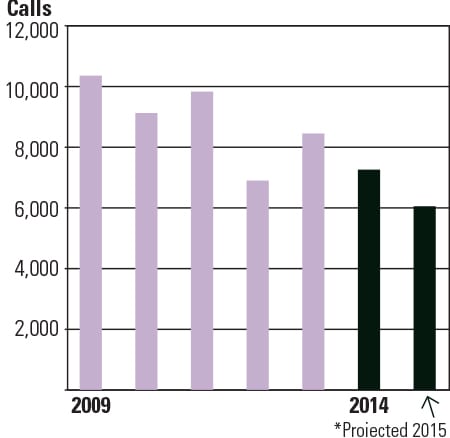 |
|
6. More technology, less trouble. Even with an increase in the use of computer-based solutions, the technical assistance center has seen its call volume decrease. Courtesy: STP Nuclear Operating Co. |
At least some of the reduction in call volume can be attributed to a new self-service application that was created by STP IT developers. The application allows customers to create their own technical assistance calls and find resolutions to common problems within the site wiki page. Allowing site users to manage their own requests has improved TAC call volume, thereby freeing TAC to do more value-added work.
“People like to use technology, and IT provides tools that are easy and efficient to use, helping make the work experience a bit more enjoyable and the entire organization more effective,” said Capristo.
STP’s IT department continues to partner with others to gain efficiencies and improve performance. Developing long-term relationships with operations, maintenance, engineering, and other departments is expected to result in greater success for the company.
“Information Technology’s strategy is building a culture of continuous improvement at all levels of IT. It is focused on the strategic priorities of the business—providing the right information, at the right time, to the right people. STP’s success is about its people. With the right people coupled with the right attitudes, tools, skills, and business intelligence, anything is possible,” said Kathy Goodrich, manager of information technology for STP. ■
—Heather Caddie-Mendiola is staff network administrator for STP Nuclear Operating Co.
